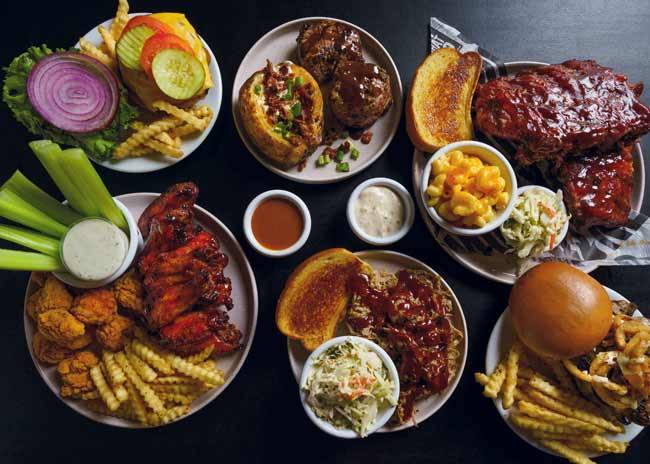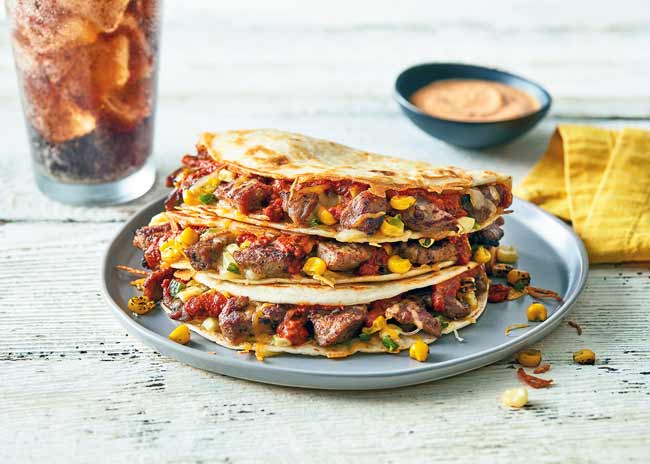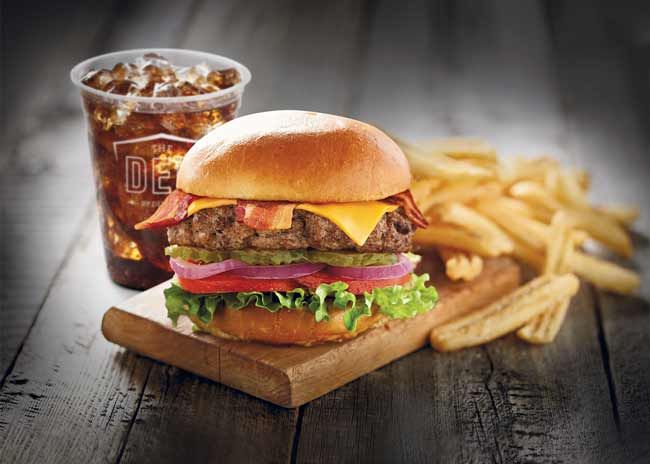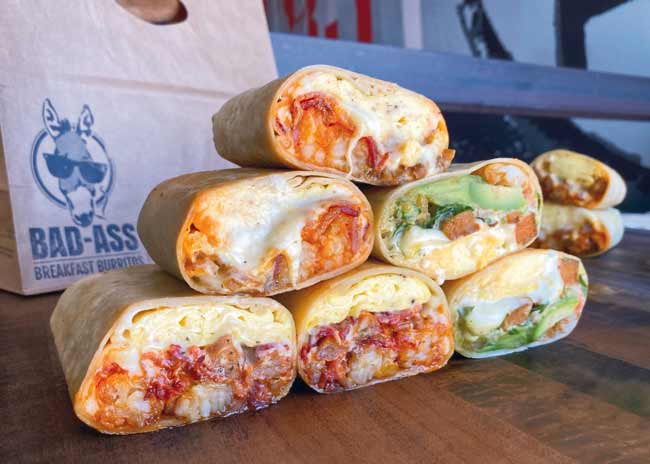Chain leaders share lessons learned
For some restaurant companies, virtual brands are proving to be much more than flash-in-the-pan ideas hatched during the pandemic as a way to keep the lights on and grills fired up. They’ve shown actual success, demonstrated growth potential and become long-term, highly strategized members of the family.
 Presumably, anyone with a commercial kitchen and the ability to offer delivery (via first- or third-party) can make a virtual brand work, either on their own or by licensing plug-and-play concepts from the many virtual brand development firms now out there seeking host restaurant partners. The formula behind virtual brands is simple: existing equipment + existing labor + digital-/delivery-only brands = more revenue with little to no extra investment.
Presumably, anyone with a commercial kitchen and the ability to offer delivery (via first- or third-party) can make a virtual brand work, either on their own or by licensing plug-and-play concepts from the many virtual brand development firms now out there seeking host restaurant partners. The formula behind virtual brands is simple: existing equipment + existing labor + digital-/delivery-only brands = more revenue with little to no extra investment.
Companies committed to mastering the art of virtual brands insist the formula actually does work — they’ve created strong new revenue streams by leveraging existing operations. But in the process of bringing virtual brands to life, they’ve learned that strategic commitment and, in some cases, a willingness to invest and innovate around them to maximize results are required. And they’re quick to note that their virtual brands are just part of broader evolutionary moves being made to adapt to changing consumer demands and dining habits toward off-premises.
Alison Glenn Delaney, chief brand officer at Ascent Hospitality Management, parent of Huddle House and Perkins Restaurant & Bakery, says virtual brands hold strong potential for legacy family-style and casual-dining concepts like Ascent’s. “Even before the pandemic, it was increasingly difficult for traditional sit-down restaurants to fill their dining rooms,” Delaney says. “The pandemic accelerated that, forcing chains like ours to say, ‘Wow, virtual brands could really help us in the short term and give us another revenue stream to compensate for loss of dine-in business.’ But we also realized that by embracing virtual brands as a long-term strategy, we can better utilize our kitchens and spread costs out over more sales.”
Over the past two years, Ascent added two stand-alone virtual brands: MrBeast Burger, which it licenses through Virtual Dining Concepts, and Papa Corazón’s Quesadillas, created internally at Huddle House and soon thereafter expanded to Perkins. As of mid-January, both concepts were implemented in almost all company-owned units, and franchisees had begun onboarding them.
“We started with MrBeast Burger and quickly saw that it was a tremendous additional revenue channel,” Delaney notes. “That’s now in about 100 Perkins units systemwide, and we have a lot of franchisees in the pipeline adding it soon. It should be in about two-thirds of our system by the end of this year. Based on our early success with MrBeast Burger, we decided to create our own quesadilla-focused virtual brand, Papa Corazón’s. It’s now adding significantly to our volumes, and we’re launching it to our franchisees,” she adds. “We don’t have virtual brands in every location, though. It really depends on whether they’re in a trade area with strong third-party delivery business because, by definition, these brands are executed through those platforms.”
The company added a third brand, Bakery by Perkins, to its digital, delivery-focused offerings — a prime example of how restaurants can think outside the box to create new revenue streams from existing business. Delaney describes it as a simple second storefront featuring the same products already sold in Perkins restaurants. The new digital storefront is now operational in roughly two-thirds of Perkins units nationwide.
“It’s really about understanding how the digital world works and learning to maximize your presence in the search engines and algorithms of the various platforms,” Delaney says of the storefront’s development. “The upshot is that, just by having this second online platform with dedicated Bakery by Perkins branding, we’re getting significant incremental bakery sales. It’s very, very easy. No new equipment or product development needed, no new processes or staffing. We’re charged a little more by our online hosting service for the additional platform, but that’s been the only new cost.”
 Papa Corazón’s Quesadillas, produced in Huddle House and Perkins’ restaurant kitchens, was conceived of in part to help grow sales in off-peak dayparts with existing equipment and SKUs. Photo courtesy of Ascent Hospitality Management
Papa Corazón’s Quesadillas, produced in Huddle House and Perkins’ restaurant kitchens, was conceived of in part to help grow sales in off-peak dayparts with existing equipment and SKUs. Photo courtesy of Ascent Hospitality Management
Play to Strengths, Fill Gaps
That general approach — analyzing existing menus and operations to leverage assets into new, tightly focused, delivery-only concepts — is one embraced by many operators going down the virtual brands path. In some cases, as with Bakery by Perkins, it might mean targeting particular menu items or categories for spinning off a virtual brand. In others, as with Papa Corazón’s Quesadillas, it might mean evaluating existing equipment, SKUs and/or opportunities to boost volume with underutilized assets in off-peak dayparts. In others still, as with Ascent’s addition of MrBeast Burger, created by YouTuber Jimmy Donaldson, it might mean appealing to a new and different demographic than those who typically patronize the legacy brands.
At family-dining chain Denny’s, which since 2021 has introduced The Burger Den and The Meltdown virtual brands, efforts to develop those new revenue channels involved all such considerations. The results so far have been encouraging, according to Dave Coltrin, vice president, guest experience and marketing technology, who says Denny’s sees virtual brands as long-term growth opportunities.
The Burger Den is now available at 1,100 restaurants nationwide and The Meltdown at 930 units. Coltrin says sales have stayed consistent and highly incremental since their launch, accounting for approximately 3% of domestic average weekly sales. From a daypart perspective, he adds that both virtual concepts have been hits with dinner and late-night consumers, a boon for the breakfast- and lunch-heavy chain.
“We very intentionally developed both brands so that our restaurant teams could seamlessly operate them out of existing Denny’s kitchens — many of which are open 24/7 — without any new equipment or changes to the spaces,” Coltrin notes. “This means our franchisees can leverage the assets they already have in operation and our restaurant team members are working in spaces they’re familiar with, with processes they’ve already mastered.”
Hagop Giragossian, a founding partner at fast-casual Dog Haus, says the same approach works well for the gourmet hot dog, sausage, burger and beer garden chain. Since 2020, Dog Haus, under parent umbrella The Absolute Brands, has introduced four virtual brands that were strategically designed to boost volume and/or fill in dayparts largely by doing what its operations teams already do well. While the company experimented with a virtual brand developed by a third party early on, it quickly pivoted to an internally driven strategy for creating and executing its virtual brands.
“The partner we worked with did an amazing job of creating the concept and making it easy,” Giragossian recalls. “But in watching our team try to complete orders, there was such disruption between what would happen when it was a Dog Haus order and what would happen when we tried to make the orders for this other virtual brand. Even though it was easy, it was still disruptive to our process. When we developed our own virtual brands, the disruption went away. The tickets print the way our normal orders print. Ingredients are exactly where they would normally be. Stations don’t change. Nothing changes. Increased volume is the only challenge we’ve needed to solve for, but that’s one our franchisees have gladly tackled. It’s better to solve for busy than for slow.”
All Dog Haus franchisees can opt to offer any or all of The Absolute Brands’ virtual concepts, which include Bad-Ass Breakfast Burritos, Bad Mutha Clucka (Nashville hot chicken), Big Belly Burgers, Jailbird (wings) and Plant B (vegetarian). In collaboration with Impossible Foods, Dog Haus also added The Impossible Shop, a virtual brand now offered from all Dog Haus restaurants.
 Sales of Denny’s The Burger Den (above) and The Meltdown (left) virtual brands have remained consistent and highly incremental since their launch in 2021. Photo courtesy of Denny’s
Sales of Denny’s The Burger Den (above) and The Meltdown (left) virtual brands have remained consistent and highly incremental since their launch in 2021. Photo courtesy of Denny’s
Dog Haus’ virtual brands have grown to the point that, for some franchisees — even those in small, older units — they now generate nearly half of total revenues. Bad-Ass Breakfast Burritos has been the biggest winner, Giragossian adds, and one that the chain may eventually even license to other restaurant companies. “We could probably do some pretty great things with partners that aren’t Dog Haus franchisees just because now we understand how important it is for this to be seamless,” he says.
For casual-dining chain Smokey Bones, which offers four virtual brands from all 62 of its restaurant locations for delivery, carryout or curbside-pickup, a key to seamless integration has been strict adherence to a development strategy that president and CEO James O’Riley describes as “forward differentiating with backward compatibility.”
Forward differentiating means “building distinct brands that have a reason for being,” O’Riley says. “Differences in performance between companies whose virtual brands have endured and grown the past three years and those that have not has a lot to do with forward differentiation. Some companies during the pandemic launched virtual brands that were so much like their base brands that once the pandemic subsided their reason for being became less obvious. We believed from the beginning that for a virtual brand to be strong and be incremental, it has to have a unique and distinct reason for being.”
Even before the pandemic, in 2019, Smokey Bones was working with Uber Eats to pioneer two virtual brands, The Burger Experience and The Wing Experience. Convinced of the viability of these new channels, the chain has since made virtual brands a key part of its internal growth strategy. In 2022, it added two more concepts, Tender Box and Bowl Market.
Explaining forward differentiation via The Wing Experience, O’Riley says the brand’s promise is jumbo wings available in 50 different flavors. “We know flavor variety is the most important benefit to chicken wing consumers. No wing concept has as many flavors as The Wing Experience,” he says. “That’s a big forward-differentiating aspect for that brand.”
The second part of Smokey Bones’ virtual brands formula — backward compatibility — focuses on creating something new out of what already exists. “There’s a high degree of overlap in the execution, procedures, SKUs, training and point of sale around the menus for our virtual brands and our legacy brand,” O’Riley says. “There’s very little, if anything, new that our back-of-house/culinary people have had to learn how to do. They already knew how to make wings, burgers, sides, bowls and chicken tenders. They’re all on our regular Smokey Bones menu, so there’s backward compatibility. If we were to try to create a virtual brand around pizza, that’s something our kitchens have no experience in. The capital investment, training, learning curve, etc., would be very steep, and the ROI would be driven way down.”
Optimize Operations
While few new or different elements were required for Smokey Bones to build its virtual brand portfolio — cooklines haven’t changed, for example — O’Riley says the commitment to growing with them and to enhancing off-premises capabilities, in general, has led to a few significant changes in other areas to better integrate and operationalize these brands. Among the biggest has been the creation of a dedicated off-premises area in the back of all Smokey Bones’ restaurant kitchens, which required reconfiguration of some equipment, storage and technology.
“Off-premises business has become so significant that we now expedite food differently,” O’Riley says. “All off-premises orders, whether from Smokey Bones or a virtual brand, are expedited to this off-premises area. We have all of the packaging, cutlery, condiments, a dedicated kitchen display system, phones, etc., there. The benefit is that orders come in as they always have, and the culinary staff focuses on doing what they’ve always done — preparing great, delicious food. That food then gets expedited to the off-premises area, where dedicated employees package it, add the extras and apply the appropriate labeling.”
Another big move made to better accommodate and market its virtual brands is the introduction late last year of Bite Hall, an e-commerce platform that brings all five of Smokey Bones’ brands together under one digital roof. Through BiteHall.com, guests can mix and match from among the brands in one order with one check and one delivery. The consolidated platform also reduces packaging needs and enables cross-promotion. Orders for all brands are now packaged in Bite Hall bags that carry the logos of all the brands available on the platform.
In fact, solving for packaging challenges was a primary inspiration for creating Bite Hall, O’Riley says. “Early on, when we had only two virtual brands, we had dedicated packaging for each of them, as well as for Smokey Bones’ off-premises orders,” O’Riley notes. “When we added two more brands to the mix, trying to manage dedicated packaging for five brands coming out of one kitchen was difficult. Putting all of the brands under one differentiated roof has helped us meet that challenge.”
Incorporating all that the company has learned over the past few years about off-premises and virtual brands, Smokey Bones recently introduced a new restaurant prototype that reflects its continued evolution from traditional, primarily dine-in casual dining brand to multi-brand, multi-channel competitor. Kitchens in the new prototype have been reconfigured to include larger off-premises expediting areas that feed into dedicated off-premises side entrances to the restaurants for fast and easy order pickup. Full drive-thru service (not just mobile-order pickup) is also now being piloted at a new model in Bowling Green, Ky. “We’ve made larger and more unique equipment investments there to enable us as a casual-dining concept to operate a full-service drive-thru,” O’Riley says. “But where we’re simply operationalizing for virtual brands, it’s mostly a matter of adding capacity because sales from those brands are incremental.”
To facilitate the extra volume at Dog Haus, Giragossian says his team evaluates each brand by category to determine if and when additional equipment capacity is necessary. “Nothing is new,” he says. “We’ve always fried tots, fries and tenders, etc. We’re just doing more of them, in some cases a lot more. It’s about analyzing throughput. How many things are we frying? Should we have a dedicated fry side? Is that going to help us, because now we fry way more tater tots than we used to for breakfast burritos? That’s the most challenging thing that has happened — and not just because of the virtual concepts but because of the presence of digital orders from third parties. It’s easy to gauge how many people are ordering when they’re standing right there in line, but when you start adding in all the third-party ordering and then add in third-party ordering for virtual concepts, there’s no easy way to manage that line and that expectation. So balancing throughput is the biggest challenge right now, not because of virtual brands, per se, but because now more than half of our business is off-premises.”
 Bad-Ass Breakfast Burritos, one of several virtual brands created by Dog Haus and its parent, The Absolute Brands, has succeeded to the point that the company is considering licensing it in the future.
Bad-Ass Breakfast Burritos, one of several virtual brands created by Dog Haus and its parent, The Absolute Brands, has succeeded to the point that the company is considering licensing it in the future.
Giragossian adds that this trend has led Dog Haus to develop units over the past year with slightly smaller dining rooms and larger kitchens, by approximately 100 square feet. Changes to kitchen layouts are also being tested, including both face-to-face lines and back-to-back lines, with both versions ending at large, T-shaped expediting stations.
“Expo is a big part of the equation, and it’s gotten more complicated because of all of the different packaging,” Giragossian notes. “We try to limit the packaging we’re using for the various concepts, keeping it pretty generic and using stamps and stickers to differentiate our brands. But we can’t always do that. For the Impossible Shop, for example, which is a collaboration, they have their own wrapper, box, bag, etc. The food production part of that one is easy, but the packaging becomes a bit more challenging.”
Both Delaney and Coltrin are quick to emphasize that, while none of their virtual brand initiatives have necessitated any changes to kitchen equipment or layout — that’s entirely the point, after all — their kitchens, too, are changing with virtual brands as part of the bigger picture. And that picture is sharply focused on better positioning operations to grow off-premises sales in general.
“It’s not specific to virtual brands, but as we’ve worked on a new prototype, we devised an entirely new kitchen, expediting area and even guest flow for new restaurants going forward,” Delaney says. “And all of the orders for all of the brands, off-premises or on-premises, now flow through one program that funnels everything into our POS and kitchen display system.”
Among the physical modifications in Perkins’ new prototype: additional storage and an oven integrated into the cookline to eliminate employees having to walk to someplace else to execute certain menu items; significantly increased space at the front counter for staging to-go orders and ensuring smooth traffic flow for the various customer groups; a dedicated to-go area near expediting with enough space to give employees easy access to everything they need to ensure order accuracy for the various brands; and a new drive-thru pickup window near the front cashier that enables delivery drivers and/or guests to quickly and easily pick up remotely placed virtual- or legacy-brand orders.
Coltrin says Denny’s, too, continues to focus on overall brand evolution, in which kitchen modernization and technology transformation are two long-term strategies. “Even before virtual brands, we recognized the need to invest in off-premises and launched our Denny’s on Demand platform,” he notes. “That gave us a leg up because the online ordering infrastructure and training was already in place. Orders from virtual brands and Denny’s on Demand come through the same platform, which simplifies things for our teams. Our virtual brands are proof points for these strategies and demonstrate how we can keep improving the overall efficiency of our kitchens.”
Designer Intel: 5 Tips for Real Success
Ryan Day, a former executive chef who now serves on the design and project management teams at Southfield, Mich.-based consultancy Great Lakes Culinary Designs, sees off-premises as a long-term trend impacting how designers and restaurateurs approach layout and operations. “We need to embrace change and understand that doing so might modify how foodservice establishments currently operate,” he says. “Virtual brands can be a part of that, and if that modification ultimately leaves a restaurateur with a more successful, profitable business, all the better.”
To that end, Day suggests five key things operators should consider to help ensure the success of virtual brands:
Choose a menu concept that’s somewhat distinctive but easily produced on existing equipment, with existing infrastructure, processes and SKUs.
Carefully evaluate equipment and operations to identify how and at what times of day underutilized assets could be used for the production of virtual brands without impacting the dine-in guest experience.
Consider storage needs and delivery schedules. Even if using the same SKUs as a legacy brand, adding virtual concepts may increase dry and cold storage space needs. And more frequent deliveries may be necessary to ensure sufficient product is on hand to support all brands and all channels.
Find or create extra space for well-organized expediting, packaging and pickup areas.
If possible, add a separate access point for delivery drivers, ideally toward the back or side of the building and out of sight and traffic flow of dine-in guests.




